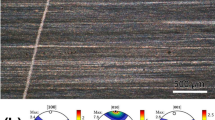Abstract
Vermicular glaucony grains observed by transmission electron microscopy (TEM) show three irregularly alternating zones. Zone A has a high degree of linear orientation, no void space, and relatively defect-free lattice-fringe images. Zone B has an amalgamated bundle texture with a sub-parallel, linear orientation of bundles to each other and to zone A. Zone B has little or no void space, and lattice images appear to be a combination of those typical of zone C with minor amounts of modified zone A forms. Zone C has a randomly oriented, curved, and circular or semicircular bundle texture. In addition, zone C has much void space and curvilinear and linear lattice-fringe images with numerous defects, including edge dislocations. Such morphologic and crystallographic characteristics indicate that zones B and C probably comprise the glauconitic minerals of the vermicular glaucony grains, and that zone A comprises non-glauconitic micaceous minerals of higher structural order. Zone B is sharply demarcated from zone A, but B zone bundle textures merge gradationally to those of zone C. These spatial relationships suggest that zone B forms first on the surface of zone A. Sub-parallel orientation in the B zone could be produced by initial confinement between adjacent A zones. Once constraints change or are removed, the randomly oriented, curved, and semicircular or circular bundles of zone C develop.
Similar content being viewed by others
References
Amouric, M. and Parron, C. (1985) Structure and growth mechanism of glauconite as seen by high-resolution transmission electron microscopy: Clays & Clay Minerals 33, 473–482.
Banfield, J. F. and Eggleton, R. A. (1988) Transmission electron microscope study of biotite weathering: Clays & Clay Minerals 36, 47–60.
Brown, E. H. (1963) The geology of the Mt. Stoker area, Eastern Otago. Part 1. Metamorphic geology: N. Z. J. Geol. Geophys. 6, 847–871.
Burst, J. F. (1958a) “Glauconite” pellets: Their mineral nature and applications to stratigraphic interpretations: Bull. Am. Assoc. Petrol. Geol. 42, 310–327.
Burst, J. F. (1958b) Mineral heterogeneity in “glauconite” pellets: Amer. Mineral. 43, 481–497.
Carter, R. M. and Norris, R. J. (1976) Cainozoic history of southern New Zealand: An accord between geological observations and plate-tectonic predictions: Earth Planet. Sci. Lett. 31, 85–94.
Carter, R. M. (1988) Post-breakup stratigraphy (Kaikoura Synthem: Cretaceous-Cenozoic) of the continental margin of southeastern New Zealand: N. Z. J. Geol. Geophys. 31, 405–429.
Galliher, E. W. (1935) Geology of glauconite: Bull. Am. Assoc. Petrol. Geol. 19, 1569–1601.
Iijima, S. and Buseck, P. R. (1978) Experimental study of disordered mica structures by high resolution electron microscopy: Acta. Cryst. A34, 709–719.
Ireland, B. J., Curtis, C. D., and Whiteman, J. A. (1983) Compositional variation within some glauconites and illites and implications for their stability and origins: Sedimentology 30, 769–786.
Lee, J. H., Ahn, J. H., and Peacor, D. R. (1985) Textures in layered silicates: Progressive changes through diagenesis and low-temperature metamorphism: J. Sedim. Petrol. 55, 532–540.
McMillan, S. G. (1993) The Abbotsford Formation: Ph.D. thesis, University of Otago, Dunedin, New Zealand, 646 pp.
Norris, R. J., Carter, R. M., and Turnbull, I. M. (1978) Cainozoic sedimentation in basins adjacent to a major continental transform boundary in southern New Zealand: J. Geol. Soc. Lond. 135, 191–205.
Odin, G. S. (1972) Observations nouvelles sur la structure de la glauconie en accordeón: Description du processus de genèse par néoformation: Sedimentology 19, 285–294.
Odin, G. S., éd. (1988) Green marine clays: Developments in Sedimentology 45, Amsterdam, Elsevier, 445 pp.
Odin, G. S. and Matter, A. (1981) De glauconiarum origine: Sedimentology 28, 611–641.
Page, R. H. (1980) Partial interlayers in phyllosilicates studied by transmission electron microscopy: Contrib. Mineral. Petrol. 75, 309–314.
Phakey, P. P., Curtis, C. D., and Oertal, G. (1972) Transmission electron microscopy of fine-grained phyllosilicates in ultra-thin rock sections: Clays & Clay Minerals 20, 193–197.
Tapper, M. and Fanning, D. S. (1968) Glauconite pellets: Similar X-ray patterns from individual pellets of lobate and vermiform morphology: Clays & Clay Minerals 16, 275–283.
Vali, H. and Köster, H. M. (1986) Expanding behaviour, structural disorder, regular and random irregular interstratification of 2:1 layer silicates studied by high resolution images of transmission electron microscopy: Clay Miner. 21, 827–859.
Wood, B. L. (1968) Otago Schist: in Geological Map of the Dunedin District. 1:50.000, W. N. Benson, ed., New Zealand Geological Survey Miscellaneous Series Map 1, Department of Scientific and Industrial Research, Wellington, New Zealand.
Author information
Authors and Affiliations
Rights and permissions
About this article
Cite this article
McMillan, S.G. The Microstructure of Vermicular Glaucony. Clays Clay Miner. 42, 63–70 (1994). https://doi.org/10.1346/CCMN.1994.0420108
Received:
Accepted:
Published:
Issue Date:
DOI: https://doi.org/10.1346/CCMN.1994.0420108




